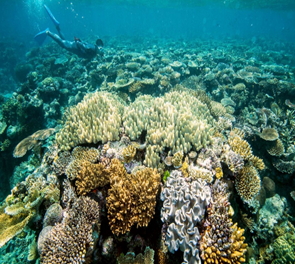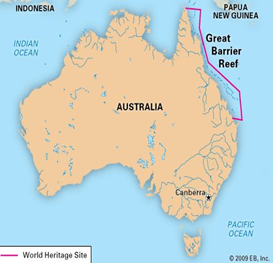Great Barrier Reef’s Recovery and Vulnerability to climate threats
- Posted By
10Pointer
- Categories
Environment
- Published
9th Aug, 2022
-
Context
Recently, an annual long-term monitoring report by the Australian Institute of Marine Science (AIMS) was released on the Great Barrier Reef’s recovery and vulnerability to climate threats.
- The reefs are surveyed through in-water and aerial techniques.


Key-Findings
- The highest levels of coral cover, within the past 36 years, has been recorded in the northern and central parts of Australia’s Great Barrier Reef (GBR).
- This could be quickly reversed owing to rising global temperatures.
- It came after the reef experienced a mass coral bleaching event in March, 2022.
- Coral cover is measured by determining the increase in the cover of hard corals.
- The hard coral cover in northern GBR had reached 36% while that in the central region had reached 33%.
- Meanwhile, coral cover levels declined in the southern region from 38% in 2021 to 34% in 2022.
- Reef systems are resilient and capable of recovering after disturbances such as accumulated heat stress, cyclones, predatory attacks and so on, provided the frequency of such disturbances is low.
- Incidentally, these fast-growing corals are also the most susceptible to environmental pressures such as rising temperatures, cyclones, pollution, crown-of-thorn starfish (COTs) attacks which prey on hard corals and so on.
- The world is going to experience heating at 1.5°C in the next decade, the temperature at which bleaching becomes more frequent and recovery less impactful.
What are coral reefs?
- Corals are marine invertebrates or animals which do not possess a spine.
- They are the largest living structures on the planet.
- Each coral is called a polyp and thousands of such polyps live together to form a colony, which grows when polyps multiply to make copies of themselves.
- Corals are of two types — hard corals and soft corals.
- Hard corals extract calcium carbonate from seawater to build hard, white coral exoskeletons. Hard corals are in a way the engineers of reef ecosystems and measuring the extent of hard coral is a widely-accepted metric for measuring the condition of coral reefs.
- Soft corals attach themselves to such skeletons and older skeletons built by their ancestors. Soft corals also add their own skeletons to the hard structure over the years. These growing multiplying structures gradually form coral reefs.
Australia’s Great Barrier Reef
- The reef is located in the Coral Sea, off the coast of Queensland, Australia.
- This reef was selected as a World Heritage Site in 1981.
- A large part of the reef is protected by the Great Barrier Reef Marine Park.
- Australia’s Great Barrier Reef is the world’s largest reef system stretching across 2,300 km and having nearly 3,000 individual reefs.
- It hosts 400 different types of coral, gives shelter to 1,500 species of fish and 4,000 types of mollusc.
Significance of Australia’s Great Barrier Reef
- Coral reefs support over 25% of marine biodiversity even as they take up only 1% of the seafloor.
- The marine life supported by reefs further fuels global fishing industries.
- Coral reef systems generate $2.7 trillion in annual economic value through goods and service trade and tourism.
- In Australia, the Barrier Reef, in pre-COVID times, generated $4.6 billion annually through tourism and employed over 60,000 people including divers and guides.

